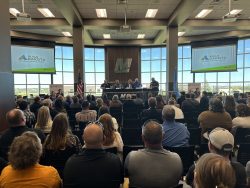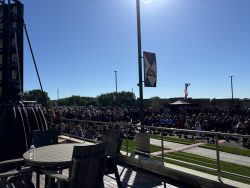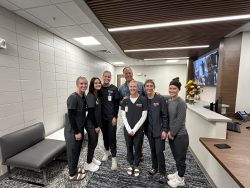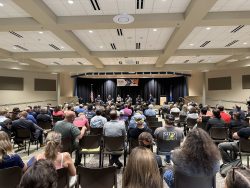
Six years ago, I told you about a skilled trades initiative in South Dakota that raised $50 million to close the ever-widening skills gap. The initiative was called “Build Dakota,” and it was different from similar efforts I’ve seen over the years.
In short, Build Dakota was launched when a wealthy businessman had offered to donate $25 million to reinvigorate the trades, but only if the sitting Governor agreed to match it. I don’t know if the businessman, T. Denny Sanford, was surprised when the Governor, Dennis Daugaard, took him up on his offer, but I sure was. I was also intrigued by the private/public aspect of the alliance, and flew up to The Mount Rushmore State to offer my support. Last week, six years after my last visit, I flew back to see if the “Build Dakota” initiative worked. Spoiler alert…
It did.
 Over the course a single day, (and with the help of a private plane, a helicopter, and a trolley car,) I was able to visit all four of the major technical colleges in South Dakota, where I saw firsthand the incredible impact this program has had on so many people. I was given a tour of all four technical colleges in the state – Southeast Tech in Sioux Falls, Lake Area Tech in Watertown, Mitchell Tech over in Davison County, and finally, all the way over to Rapid City to Western Dakota Tech. Along the way I shook a few thousand hands and met dozens of Build Dakota scholarship recipients as well as several mikeroweWORKS scholarship winners. I gave several speeches, participated in a series of fireside chats, (without the fire), and assisted with a ribbon cutting ceremony at Lake Area Tech, made memorable by the fact that the “ribbon” was made of metal and the “scissors” were a cutting torch. I also met a few of the 600 local business owners who are actively supporting this program – many of w
Over the course a single day, (and with the help of a private plane, a helicopter, and a trolley car,) I was able to visit all four of the major technical colleges in South Dakota, where I saw firsthand the incredible impact this program has had on so many people. I was given a tour of all four technical colleges in the state – Southeast Tech in Sioux Falls, Lake Area Tech in Watertown, Mitchell Tech over in Davison County, and finally, all the way over to Rapid City to Western Dakota Tech. Along the way I shook a few thousand hands and met dozens of Build Dakota scholarship recipients as well as several mikeroweWORKS scholarship winners. I gave several speeches, participated in a series of fireside chats, (without the fire), and assisted with a ribbon cutting ceremony at Lake Area Tech, made memorable by the fact that the “ribbon” was made of metal and the “scissors” were a cutting torch. I also met a few of the 600 local business owners who are actively supporting this program – many of w hom offer guaranteed employment to graduates of the aforementioned schools.
hom offer guaranteed employment to graduates of the aforementioned schools.
 I can’t overstate the importance of local industry support. That’s the missing ingredient in so many similar initiatives, and the key to why this is working so well. Most importantly, I talked to the local press at each location about why this program should be a template for the rest of the country. I challenged the press to tell this story far and wide, and I encourage all of you to share it as well. Because from what I can see, this is the way forward. The skills gap will only close when other business leaders and other Governors in other states follow South Dakota’s example.
I can’t overstate the importance of local industry support. That’s the missing ingredient in so many similar initiatives, and the key to why this is working so well. Most importantly, I talked to the local press at each location about why this program should be a template for the rest of the country. I challenged the press to tell this story far and wide, and I encourage all of you to share it as well. Because from what I can see, this is the way forward. The skills gap will only close when other business leaders and other Governors in other states follow South Dakota’s example.
 You know the stats by now, and the challenges of close the skills gap. For every 5 tradespeople that retire, 2 enter the workforce. That’s a 5:2 ratio, and the math is simply not sustainable. Part of the problem is an aging workforce, but the
You know the stats by now, and the challenges of close the skills gap. For every 5 tradespeople that retire, 2 enter the workforce. That’s a 5:2 ratio, and the math is simply not sustainable. Part of the problem is an aging workforce, but the  bigger issue is a lack of enthusiasm for millions of good jobs, fueled by decades of myths and misconceptions surrounding the trades. In this regard, the skills gap is also a “will gap,” and if we don’t do something to reinvigorate the trades on a national level, I’m afraid we’re going to be in a world of hurt.
bigger issue is a lack of enthusiasm for millions of good jobs, fueled by decades of myths and misconceptions surrounding the trades. In this regard, the skills gap is also a “will gap,” and if we don’t do something to reinvigorate the trades on a national level, I’m afraid we’re going to be in a world of hurt.
Just a few months ago, I was talking to the people at Blue Forge Alliance. These guys are charged with helping the Navy Industrial Submarine Base recruit 100,000 skilled tradespeople…in the next nine years. That’s not a typo. America’s Industrial Submarine Base – a collection of nearly 15,000 individual companies – need to hire a hundred thousand tradespeople to complete the work on four nuclear powered submarines. And they’re struggling to find them.
“Where are all the tradesmen?” they asked me.
“Well, at the moment,” I said, “most of them are in the eighth grade.”
I wasn’t joking. The fact is, every skilled tradesperson I know who wants to work, is working. And every company I know that relies upon a skilled workforce is hiring. Many of those companies are desperate to do so, and others are starting to panic, because the supply of welders, electricians, plumbers, linemen, and pipe-fitters is simply nowhere near the demand. The solution – or at least, part of the solution – is in South Dakota. Build Dakota has provided full ride scholarships to over 3,500 individuals, all of whom have pledged to work for at least three years in South Dakota. That’s $43 million in statewide scholarships specifically for trade schools. Because the money was also invested wisely and not handed out all at once, there’s also a sizeable endowment, ensuring more scholarships in the years to come.
 If you want to learn more about how they pulled this off, go to https://www.builddakotascholarships.com/. Then, ask yourself what the business leaders and elected officials in your state are waiting for. This approach is working. It’s been proven, beyond a shadow of a doubt. It worked in South Dakota, and it will work in your state, too.
If you want to learn more about how they pulled this off, go to https://www.builddakotascholarships.com/. Then, ask yourself what the business leaders and elected officials in your state are waiting for. This approach is working. It’s been proven, beyond a shadow of a doubt. It worked in South Dakota, and it will work in your state, too.
